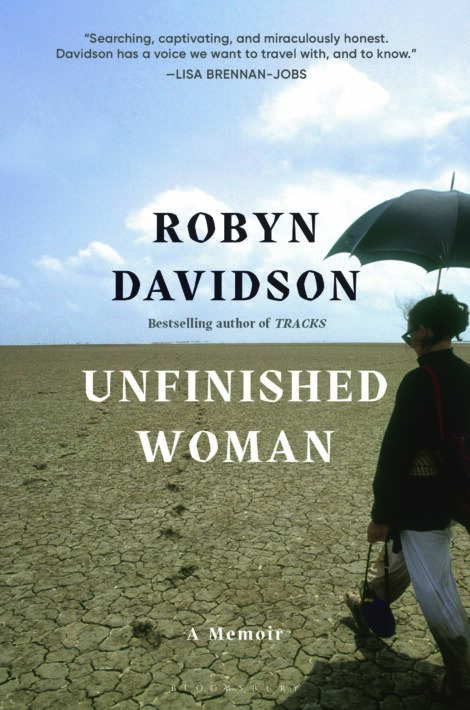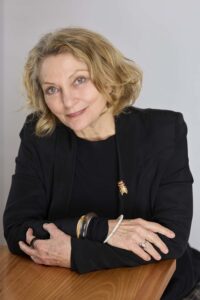
UNFINISHED WOMAN
A spellbinding memoir exploring time and memory, home and belonging, from the internationally bestselling author of Tracks, “an unforgettably powerful book” (Cheryl Strayed).
In 1977, while she was in her twenties, Robyn Davidson set off with a dog and four camels to cross 1,700 miles of Australian desert to the sea.
A life of almost constant travelling followed—from the Outback to Sydney’s underworld; from sixties street life, to the London literary scene; from migrating with nomads in India and Tibet, to marrying an Indian prince. The only territory she avoided was the past.
A spellbinding memoir exploring time and memory, home and belonging, from the internationally bestselling author of Tracks, “an unforgettably powerful book” (Cheryl Strayed).
In 1977, while she was in her twenties, Robyn Davidson set off with a dog and four camels to cross 1,700 miles of Australian desert to the sea.
A life of almost constant travelling followed—from the Outback to Sydney’s underworld; from sixties street life, to the London literary scene; from migrating with nomads in India and Tibet, to marrying an Indian prince. The only territory she avoided was the past. In Unfinished Woman, she ventures into that unknown, unearthing an ache for a lost but barely remembered mother and an unmet desire to feel at home in her freedom.
Adventurous but guarded, fearless yet broken, Davidson asks: how can we live with pain and uncertainty, to find beauty in the strangeness of being? Unfinished Woman is a stunning literary achievement, inviting readers in as a world-famous wandering spirit is, for the first time, laid truly bare.
- Bloomsbury Publishing
- Hardcover
- December 2023
- 9781620401620
About Robyn Davidson
 Robyn Davidson is the author of several books, including Travelling Light, Desert Places, and the international bestseller Tracks: A Woman’s Solo Trek Across 1700 Miles of Australian Outback. Born on a cattle property in Queensland, Australia, she went to Sydney in the late sixties. Since then, she has traveled extensively, living in Brisbane, London, New York, and India, where she migrated with and wrote about nomads. She is now based in Melbourne, Australia, but spends several months a year in the Indian Himalayas.
Robyn Davidson is the author of several books, including Travelling Light, Desert Places, and the international bestseller Tracks: A Woman’s Solo Trek Across 1700 Miles of Australian Outback. Born on a cattle property in Queensland, Australia, she went to Sydney in the late sixties. Since then, she has traveled extensively, living in Brisbane, London, New York, and India, where she migrated with and wrote about nomads. She is now based in Melbourne, Australia, but spends several months a year in the Indian Himalayas.
Praise
“[Davidson] excavates her childhood, romantic life, and family traumas in this raw and thorny memoir . . . Her rueful tone and assertion that her fate often felt like ‘the playing out of forces [she] had no hand in’ hits hard. It makes for painful yet cathartic reading.” —Publishers Weekly
“Searching, captivating and miraculously honest. Davidson has a voice we want to travel with, and to know.” —Lisa Brennan-Jobs, New York Times bestselling author of Small Fry
“Immersive and profound, Robyn Davidson’s Unfinished Woman is a portal to understanding a daughter’s grief. ‘We take our mothers into us; that is where they live,’ she writes. So much of her mother’s life may remain unknown, but through memoir, Davidson completes what she considers an impossible task: crafting a moving portrait of her mother. This book will stay with me.” —Jeannie Vanasco, author of The Glass Eye
“Stunning. Robyn Davidson lives and writes with an explorer’s courage, but this book is more than an adventure story. Unfinished Woman is an unfiltered glimpse into the fierce pursuit of freedom and connection, woven with a mother-daughter bond untouchable by time.” —Kendra Atleework, author of Miracle Country
“Complex . . . well-written and insightful.” —Kirkus Reviews
Discussion Questions
- The prelude begins with the story of Davidson’s gold sandals. What do these sandals, and this story, come to represent in Unfinished Woman?
- Gwen is seventeen years younger than her husband and was raised with less money and privilege than him. How do these things affect their marriage?
- When introducing her sister’s anger in chapter 3, Davidson writes: “We are all conglomerates of habits, thematic sequences set in motion by circumstances we had no hand in.” How is this true (or not) for her sister? For her mother and father?
- Davidson describes their Polish neighbor, Ted, as her “first exogamous love.” What do you think it was about him that appealed to her? How was Ted and Bunty’s relationship similar to or different from her parents’?
- Chapter 5 focuses on Davidson’s early schooling at Mooloolah State School. How did this small, rural school shape her views on formal education?
- How did Gwen’s parents, Nanna and Grandy, influence Davidson?
- Davidson writes: “My father’s gaze was a romantic gaze. It was directed at the horizon. It contained distances.” What do you think of how Davidson views her father?
- When speaking of why she chose to not have children, Davidson writes: “It bewildered me to see how casually people replicated themselves, without thinking about their fitness for the job or the future happiness of the child.” What do you think about this statement?
- How did Davidson’s great-aunt Gladys and aunt Gil model “another way of being female in the world”?
- Davidson writes: “But we never escape our mothers. Their habits of mind have life in us, either in the way we think, or in opposition to the way we wish to think.” What do you think about this idea?
- Davidson repeats the line: “And no one can live too far outside the clichés of their time.” How do you see this play out in Davidson’s life?
- How did Doris Lessing influence Davidson’s writing career and life?
- How did Davidson’s twenty-year relationship with Narendra mirror or differ from her parents’ relationship? How did you feel about him?
- In Chapter Fifteen, Davidson writes: “The way memory plays in the mind is not factual. It is sketchy, mythical, misremembered, contradictory. It is flickers of light on unfathomable darkness.” How do you see this idea play out in the narrative, and in how Davidson writes it?
- How did Davidson’s experiences in urban Sydney shape who she came to be?
- Both the prelude and the epilogue end with the sentence: “My mother is as close to me, and as hidden from me, as my own face…” Why do you think Davidson chose to begin and end her memoir with this idea?
